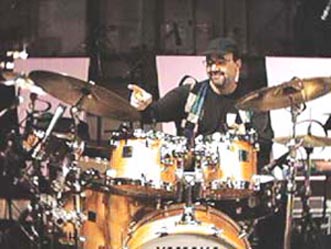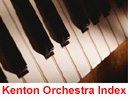Thanks to
Stan
Kenton, and my parents, I play the drums. My first real exposure to
professional
jazz
musicians occurred
when
I had just turned 7 years old and attended Stan's National Stage Band
Camp
held on the campus
of
Indiana
University in Bloomington, Indiana in the summer of 1961. Other
students
at that camp included Randy Brecker, David Sanborn, Keith Jarrett and
Don
Grolnick.
There
had been
a slight administrative mix-up: the Camp didn't realize that I was so
young
until I had arrived.
Since
my family had driven me all the way from New Jersey to Indiana, however
(and this was before the days of a
completed
Interstate Highway system), I was allowed to play personally for Stan
and
he kindly saw to my being able to attend the camp as a student. From
the
moment we met he was always 'Stan' to me . . . never 'Mr. Kenton.'
Thus
began a relationship
that had me 'sitting in' with the Kenton Orchestra whenever they played
near my
hometown of
Linwood,
New Jersey . . . usually at the Steel Pier in Atlantic City. I followed
the band and
all of Stan's
recordings
throughout the years, confident somewhere in my thoughts that I would
one
day be the drummer
on the
band.
When I
was in
high school (the Interlochen Arts Academy in Michigan), the jazz band
there
played a number of Stan's charts. After 1 year in college (Indiana
University),
I met the percussion instructor, George Gaber, through composer Johnny
Richards' recommendation. Gaber had played timpani on several tracks
for
the Kenton Orchestra's 'Cuban
Fire' album.
Several
days later
my father received a telephone call from Stan:
"Do
you think
Peter is ready to play with the band?"
Of
course my Dad
said "Yes!"
My
audition consisted
of going to New York and playing with the band at a rehearsal with June
Christy
as part of the
band's
appearance at the 1972 Newport Jazz Festival at Lincoln Center. Except
for Stan,
bassist John
Worster,
conga drummer Ramon Lopez and outgoing drummer Jerry (Lestock)
McKenzie,
the rest of the band just assumed that this long-haired kid was June
Christy's
drummer.
As I
played down
the charts I thought to myself, "Gosh, I don't remember the cymbals
being
this BIG!"
Later
I was told
I would be doing the show that night. After that it was a matter of
coordinating
my travel so that I could meet the band somewhere in the Midwest as it
continued its tour. It turns out that my first gig with the band was an
afternoon concert and clinic, followed by an evening concert at my alma
mater, Interlochen, during the
summer
camp season.
I
remember it all as being big, exciting, thrilling . . . and hard work.
I loved every minute of it!
About
one week
into the tour, while sharing a ride in the elevator of a hotel
somewhere
in Iowa, Stan casually remarked:
"You
know, Peter,
we haven't discussed money yet."
I
innocently replied,
"So . . . how much do you want me to pay you?"
I was
treated
very well by all of the members of the band. The band was like family.
I was young and I had a tremendous amount to learn! By the time I had
joined
the band I had become pretty interested in the activities of bands like
Miles Davis and Weather Report, Chick Corea's 'Return to Forever,' the
Mahavishnu Orchestra and the music of Keith Jarrett. Stan welcomed this
part of my developing musical personality, while the band patiently
waited
for me to come to grips with some big band stylistic necessities I had
yet to conquer and master.
Life
on the road
. . . playing virtually every night (or day and night, as in the case
of
the numerous clinics we did), traveling all over the country, meeting
some
of my jazz heroes at festivals and jazz clubs . . . and meeting girls .
. . cool! And, occasionally meeting other drummers who coveted my
chair!
The
band was big
and as such had a very big sound. I played with a lot of energy, but
also
with as much
respect as I
could
muster . . . particularly for the ballads; and especially for the
Johnny
Richards' ballads
from
'West
Side Story' or 'Adventures in Time!' Since I had been a fan of the
music
of Don Ellis I also welcomed the chance to play the wonderful charts of
Hank Levy.
It was
not always
easy to stay completely content while on the road so much of the year.
During my first year on the road we had 10 days off for the Christmas
Holidays
. . . otherwise, we were working the entire rest of the year.
Relationships
came and went, but, hey, I was young, so that was okay. 'Mail Day,'
when
our mail was forwarded to us on the road from Stan's office in Los
Angeles
was always a big event.
Sometimes
there
was friction between various factions of the band, which fortunately
never
lasted
too long. I also
sensed
that my touch on the instrument wasn't getting any lighter . . .
whenever
I would sit-in with a small group somewhere I didn't always sound like
I wanted to sound!
Nor did I always sound
like I wanted to sound with the band. However, Stan was an incredibly
patient bandleader, allowing me time to explore and discover my own
mistakes. At times he could be a stern
taskmaster . . .
particularly with the trumpet section (they had an incredibly demanding
job), but more often than not he was never anything less than gracious,
encouraging and loyal to me and every other member of the Orchestra:
'fatherly,' you might say.
The
audiences
loved the band. Stan had fans like no other bandleader. It was a
glorious
experience to
share and
take
part in all of that excitement.
I made
my first
professional recording with Stan, which was the 'National Anthems of
the
World' album. That began a friendship with composer/arranger Bob Curnow
which lasts to this day. We made that recording in the old
United-Western
studios in Hollywood during the summer of 1972. We worked there during
the day, then had to pack everything up and drive to Anaheim to play 4
sets each night
at
Disneyland.
We did this every day for one very long week.
Exactly
25 years
later I found myself in the same room (now known as Oceanway
Recorders),
making the Sinatraland' recording with the Pat Williams Big Band. I
could
only smile at my good fortune; for having been lucky to have met Stan
when
I was so young; to have been inspired by his music; for getting to be
part
of his organization for three years; for getting my professional start
in the business; and most of all, for getting to know Stan so well.
I have
only the
fondest memories of the man for his drive, his passion and his
commitment
for his music.

 Visit
Peter's Website at: http://petererskine.com
Visit
Peter's Website at: http://petererskine.com

 Visit
Peter's Website at: http://petererskine.com
Visit
Peter's Website at: http://petererskine.com